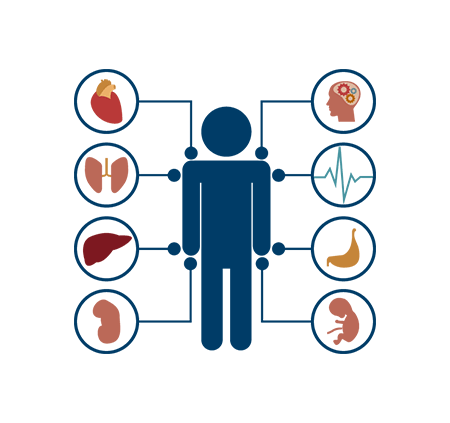Alcoholism is a disease. For most people, having a drink is a social, convivial occasion. Many alcoholics start out that way, but eventually alcohol comes to rule their lives. Some people have a genetic predisposition to alcoholism. If a close family member was an alcoholic – or if many people in the family drank to excess – there’s a good chance a genetic influence is there.
The alcoholic beverage industry creates a world where drinking is fun and sophisticated. For too many people, the reality is that drinking ruins their careers, families and health. It also reduces their lifespan, as alcoholics tend to die a decade earlier than their non-alcoholic contemporaries.
While the stereotypical alcoholic is a bum passed out on the street, alcoholism affects people from every walk of life. Men and women of all races, ethnicities, religions and classes are alcoholics – even those belonging to cultures and religions that prohibit alcohol consumption. A person doesn’t have to drink every day to be considered an alcoholic.
Risk Factors for Alcoholism and Abusing Alcohol

While genetics plays a role in developing alcoholism, that does not mean every person with a genetic predisposition will become an alcoholic, although the risk is there. Other factors for alcoholism include the age at which a person starts drinking. Those who begin drinking in adolescence are at higher risk for alcoholism than those who do not drink until after the legal age. People who grew up with a family history of violence, sexual abuse and depression are at greater risk of using alcohol to excess. Anyone suffering from undiagnosed mental illness is at greater risk of becoming alcohol dependent.
Partners or good friends who drink to excess may influence others to drink more than they should. Trying to keep up with a crowd that drinks a lot can pave the way to alcoholism.
Types of Drinking

A “drink” is based on the size of the type of alcoholic beverage. For example, a beer is defined as 12 ounces of alcohol consumed, while wine is 5 ounces and whiskey and other hard liquors are 1.5 ounces. That means wine is not safer than hard liquor – it’s simply a matter of the amount consumed. Those who have between one and two drinks daily, or less, are considered light to moderate drinkers. Even this type of drinking may have deleterious effects on some people, even though light to moderate drinkers are not considered alcoholics. Problem drinking falls into two main categories:
- Binge drinking – this type of drinking is the most common. The CDC breaks down the definition of binge drinking by gender, with women consuming four or more drinks during one session and men consuming five or more alcoholic beverages.
- Heavy drinking – the CDC defines heavy drinking as consumption of eight or more drinks weekly for women, but nearly twice that amount – 15 – for men.
The more people drink, the more their brain chemistry becomes dependent on alcohol.
Types of Alcoholics

Just as every person is unique, so is their alcoholism. Still, alcohol abusers tend to fall into basic types. You might recognize problem drinkers falling into these categories:
- Young adult – Nearly a third of alcoholics fall into this group, with an average age of 24. Many of these young adults were raised in families where heavy drinking or alcoholism was the norm. These young people tend to binge drink, consuming large quantities of alcohol all at once rather than over time. This is also the group least likely to seek help, although that may change as they age.
- Young antisocial – This group differs from the young adult alcoholic. They are even more likely to come from alcoholic homes and may use marijuana and other drugs along with alcohol. While the average age of the young, antisocial alcoholic is 26, by that time in life they may have been drinking for a decade or more.
- Functional alcoholics - These are the types most likely to slip under other peoples’ radar. They may continue to work, maintain stable relationships and appear “normal,” but sooner or later, years of heavy drinking will catch up to them.
- Intermediate familial – This person is similar to the young antisocial, although the issues start later in life, usually in the 30s. There is a high incidence of mental or emotional illness in this group.
- Chronic, severe alcoholic – These alcoholics not only drink more and more often, but often suffer from sort of mental illness. The good news is that many chronic, severe alcoholics do eventually seek help, since their situation gets to the point where even they can’t engage in denial.
Warning Signs
Many people do not realize they have a drinking problem. It’s a sensitive subject, and family members and friends may not want to bring it up until the situation is out of control. If a person absolutely must drink every day, they probably have a drinking problem. More obvious signs include drinking affecting your life, such as coming in late to work or missing work altogether because of excess drinking. Relationships may break up due to drinking. Signs of a severe drinking problem include:
- Inability to quit drinking, no matter how hard you try
- Drinking alone
- Your life revolves around drinking
- All your social activities relate to drinking, and you aren’t comfortable around sober people
- Drinking throughout the day into the evening
- Panicking if alcohol isn’t available
- Making excuses regarding your drinking
- Forgetting what happens when you drink or blacking out
- Hiding drinking from others
- Lying about drinking
- Changing the type of alcohol consumed, such as wine instead of whiskey, because you think you won’t get as drunk
- Spending large sums on alcohol
- Arrest for a DUI
- Not keeping up with your responsibilities because of drinking
- Needing to consume more alcohol to achieve the same effects.
Some alcoholics realize they have a problem but continue to use alcohol. These are individuals who may have tried to stop drinking on their own but found the withdrawal symptoms too difficult to withstand.
If someone tells you they fear you have a drinking problem, listen to them. Friends and relatives may recognize the issue long before you do.
Reasons People Drink
Why do people drink? The reasons are as unique as the individual, but drinking is part of most cultures. Some of the primary reasons people drink include:
- Peer pressure – your friends drink, and not drinking leaves you out of a social group
- Coping with stress
- Loneliness and isolation
- Instill confidence and overcome shyness
- Social norms – in many parts of society, drinking is a social norm.
- Self-medication – attempting to ease emotional or physical pain or grief.
In the short-term, alcohol can create a euphoric effect. It is also a depressant. Some people may drink to help them sleep, but that is a big mistake. While drinking can make a person sleepy, the effect is short-lived, and the individual will generally wake up in the middle of the night and find themselves unable to get back to sleep.
Health Issues from Excessive Alcohol Use

Alcohol abuse can lead to various health issues and may prove fatal. The CDC reports that excessive drinking is responsible for 10 percent of all deaths among adults aged 20 to 64 years of age. Drinking has both short-and-long-term health risks, but even the former can kill. Short-term health risks include:
- Risky sexual behavior
- Acts of violence
- Motor vehicle accidents
- Drowning
- Miscarriage
- Poor reflexes and reaction time
- Alcohol poisoning from drinking too much
- Effects of short and long term use of alcohol
- Additional health issues from mixing alcohol and drugs
That doesn’t take into account a bad hangover after a drinking bout, which may cause a worker to call in sick or perform their job when feeling impaired.
Long-term health issues stemming from alcoholism include:
- Depression
- Anxiety
- High blood pressure
- Gastrointestinal ailments
- Ulcers
- Heart disease, stroke and other cardiovascular problems
- Cancer, especially of the breast, liver, colon, mouth and esophagus
- Cirrhosis of the liver
- Hepatitis
- Pancreatitis
- Sleep apnea
- Cognitive impairment
- Neurological problems
- Vitamin and mineral deficiencies
- Compromised immune system
- Osteoporosis, or bone loss
- Memory loss
- Dementia
- Increased risk of suicide.
Women who drink during pregnancy run the risk of giving birth to children with fetal alcohol syndrome. These children suffer from brain damage and growth issues. They may have facial and limb deformities, vision or hearing problems, heart defects and intellectual disabilities. Some of these issues are treatable, but not curable. There is no safe amount of alcohol for a woman to consume when she is pregnant. Heavy drinking can also disrupt a women’s menstrual cycle.
In men, heavy drinking can reduce the amount of testosterone in their system and increase the amount of estrogen, the female hormone. That can result in erectile dysfunction and gynecomastia, or male breast development.
While drinking does not cause diabetes, drinking can cause low blood sugar in diabetics since alcohol interferes with blood glucose levels.
Many medication labels warn against combining these drugs with alcohol. The mix of alcohol and medications prescribed for various conditions can prove dangerous and even fatal.
Treatment Options

Fortunately, there are a variety of treatment options for the person who realizes they are an alcoholic.
The process begins with detoxification, and medical supervision is required. It is unwise for alcoholics to try to “dry out” by themselves. Those with a strong dependence on alcohol may suffer various withdrawal symptoms when attempting to stop drinking, including nausea, tremors, seizures and hallucinations. Worst-case scenarios include delirium tremens, a psychotic condition. Medical detoxification takes between seven and 10 days, with the end result of cleansing alcohol from the body. Detoxing patients are intensely supervised and may receive medications to help them through the ordeal. Once detoxification is complete, rehabilitation begins.
Rehabilitation – Rehab is done on an inpatient or outpatient basis, depending not only on the patient’s needs but on their insurance options. Ideally, patients are able to take advantage of inpatient facilities and the psychological, nutritional and other counseling offered for up to 90 days. These programs are intensive and quite structured. However, many insurance programs limit the amount of time at inpatient facilities to 30 to 45 days.
Outpatient facilities are a good option for those with less severe levels of alcoholism. Because there is less supervision, it may prove more difficult for some recovering alcoholics to stay sober in such an outpatient program. Such programs feature counseling, group therapy and perhaps pharmacotherapy, or the use of medications to treat alcoholism. Outpatient services may also offer educational or vocational opportunities to help alcoholics get back on their feet and head in a different direction in life. Outpatient facilities offer various ongoing supportive services to help keep patients sober.
Staying sober – The final phase of treatment is ongoing. Maintaining sobriety, also know as maintenance, often requires the help of supports groups such as Alcoholics Anonymous or counseling. Lifestyle changes are also needed. Since life no longer revolves around drinking, recovering alcoholics may find they can no longer spend time with people who still drink excessively. Part of staying sober is deciding what useful activities will take the place of the time previously spent drinking, where to spend your time and what places – and people – to avoid.
It’s also crucial to develop a support network for those moments when you feel the need to drink. With perseverance, a person can stay in the maintenance phase for the rest of their lives.
A Lifelong Challenge
There is no real cure for alcoholism. An alcoholic cannot become a social drinker, content to have one beer after work with colleagues. They might control it for a while, but eventually the need to drink more will consume them. Staying sober is a lifelong challenge, but it’s one that many alcoholics achieve. The first step towards sobriety is recognizing a problem exists. Once you’ve made that admission, anything is possible.
- https://www.cdc.gov/alcohol/fact-sheets/alcohol-use.htm
- https://www.mayoclinic.org/diseases-conditions/fetal-alcohol-syndrome/symptoms-causes/syc-20352901
- https://www.umm.edu/health/medical/reports/articles/alcoholism

